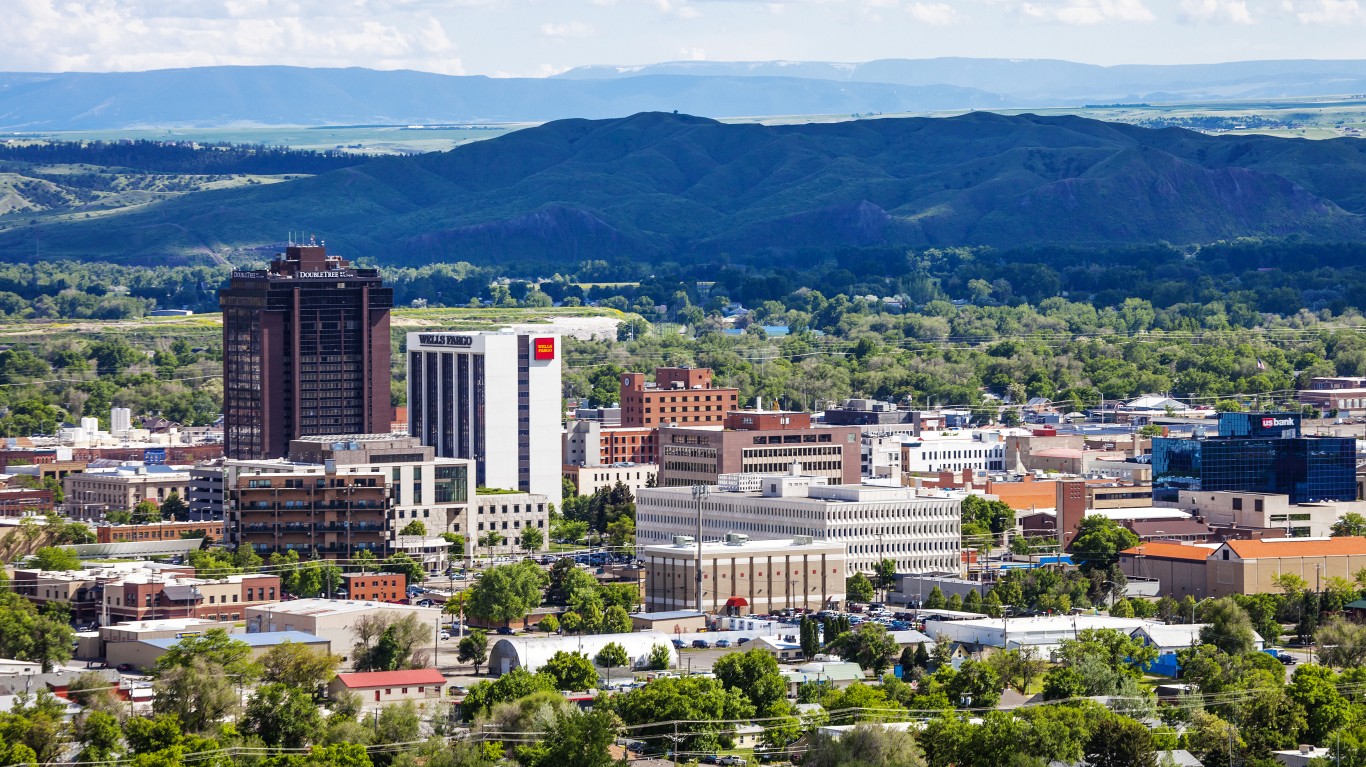Special Report
States Where Income Inequality Has Gotten Worse Since 2010

Published:
Last Updated:

The Covid-19 pandemic dealt a crippling blow to the nation. It knocked out a third of U.S. gross domestic product and sent the jobless rate into double digits last year, and has killed nearly 600,000 Americans, according to the latest estimate from the Centers for Disease Control and Prevention.
Before the virus began infecting the world, the U.S. economy was, by most macroeconomic measures, healthy. The national unemployment rate had plunged to its lowest since the late 1960s. At the same time, average private-sector nominal hourly earnings (a common measure of a worker’s income growth) were finally approaching a level unseen since before the Great Recession that began in late 2007.
But macroeconomic indicators don’t provide a complete picture. Viewing a country exclusively through that lens misses the basic fact that economics is as much a local story as a national one. For example, not all U.S. states enjoy the benefits of our modern capitalist democracy equally. (Here are the richest and poorest states.)
Click here to see the states where income inequality has gotten worse since 2010.
To identify the states where income inequality got worse between 2010 and 2019 (the most recent year for which data is available), 24/7 Wall St. looked at the change in the Gini index — a statistical measure developed by early 20th-century economist Corrado Gini, representing income or wealth inequality within a given group. A Gini coefficient of 0 means that everyone has an equal income, while a coefficient of 1 indicates maximum inequality (i.e., one person or group controls all the wealth). High income to low income ratios were calculated based on census income quintiles for the top 20% of earners and the bottom 20% of earners. All data comes from the United States Census Bureau’s American Community Survey one-year estimates for 2019.
Amid the long recovery from the worst economic crisis in more than 80 years, income inequality got worse and worse. Despite a record pre-pandemic streak of U.S. economic expansion that created jobs, resuscitated the housing market, and sent the stock market to the stratosphere, by 2019, only the top 30% of households had recovered the wealth they lost in the Great Recession, according to the Federal Reserve.
The middle and lower classes are worse off than they had been a decade earlier, while the wealthiest Americans own an ever-larger share of the nation’s prosperity. While the situation is nationwide, it’s the worst in these states where the middle class is being left behind.

47. Idaho
> Chg in Gini index of income inequality 2010-2019: +0.001
> Gini index of income inequality, 2010: 0.433 — 10th best income distribution
> Gini index of income inequality, 2019: 0.434 — 2nd best income distribution
> Typical high income to typical low income ratio, 2019: 11.61 to 1 — 2nd smallest
[in-text-ad]

46. Oregon
> Chg in Gini index of income inequality 2010-2019: +0.001
> Gini index of income inequality, 2010: 0.449 — 22nd best income distribution
> Gini index of income inequality, 2019: 0.450 — 15th best income distribution
> Typical high income to typical low income ratio, 2019: 13.79 to 1 — 15th smallest

45. Alabama
> Chg in Gini index of income inequality 2010-2019: +0.002
> Gini index of income inequality, 2010: 0.472 — 6th worst income distribution
> Gini index of income inequality, 2019: 0.474 — 19th worst income distribution
> Typical high income to typical low income ratio, 2019: 16.53 to 1 — 10th largest

44. Vermont
> Chg in Gini index of income inequality 2010-2019: +0.003
> Gini index of income inequality, 2010: 0.444 — 19th best income distribution
> Gini index of income inequality, 2019: 0.447 — 12th best income distribution
> Typical high income to typical low income ratio, 2019: 13.34 to 1 — 13th smallest
[in-text-ad-2]

43. Minnesota
> Chg in Gini index of income inequality 2010-2019: +0.003
> Gini index of income inequality, 2010: 0.440 — 15th best income distribution
> Gini index of income inequality, 2019: 0.443 — 11th best income distribution
> Typical high income to typical low income ratio, 2019: 12.89 to 1 — 10th smallest

42. Arizona
> Chg in Gini index of income inequality 2010-2019: +0.004
> Gini index of income inequality, 2010: 0.455 — 23rd worst income distribution
> Gini index of income inequality, 2019: 0.459 — 22nd best income distribution
> Typical high income to typical low income ratio, 2019: 14.22 to 1 — 22nd smallest
[in-text-ad]

41. Kansas
> Chg in Gini index of income inequality 2010-2019: +0.005
> Gini index of income inequality, 2010: 0.445 — 20th best income distribution
> Gini index of income inequality, 2019: 0.450 — 15th best income distribution
> Typical high income to typical low income ratio, 2019: 13.32 to 1 — 12th smallest

40. Massachusetts
> Chg in Gini index of income inequality 2010-2019: +0.005
> Gini index of income inequality, 2010: 0.475 — 3rd worst income distribution
> Gini index of income inequality, 2019: 0.480 — 7th worst income distribution
> Typical high income to typical low income ratio, 2019: 18.19 to 1 — 4th largest

39. Texas
> Chg in Gini index of income inequality 2010-2019: +0.006
> Gini index of income inequality, 2010: 0.469 — 8th worst income distribution
> Gini index of income inequality, 2019: 0.475 — 13th worst income distribution
> Typical high income to typical low income ratio, 2019: 15.73 to 1 — 14th largest
[in-text-ad-2]

38. Hawaii
> Chg in Gini index of income inequality 2010-2019: +0.007
> Gini index of income inequality, 2010: 0.433 — 10th best income distribution
> Gini index of income inequality, 2019: 0.440 — 7th best income distribution
> Typical high income to typical low income ratio, 2019: 13.69 to 1 — 14th smallest

37. Florida
> Chg in Gini index of income inequality 2010-2019: +0.007
> Gini index of income inequality, 2010: 0.474 — 5th worst income distribution
> Gini index of income inequality, 2019: 0.481 — 6th worst income distribution
> Typical high income to typical low income ratio, 2019: 15.50 to 1 — 16th largest
[in-text-ad]

36. Tennessee
> Chg in Gini index of income inequality 2010-2019: +0.007
> Gini index of income inequality, 2010: 0.468 — 9th worst income distribution
> Gini index of income inequality, 2019: 0.475 — 15th worst income distribution
> Typical high income to typical low income ratio, 2019: 15.17 to 1 — 23rd largest

35. Utah
> Chg in Gini index of income inequality 2010-2019: +0.008
> Gini index of income inequality, 2010: 0.419 — the best income distribution
> Gini index of income inequality, 2019: 0.427 — the best income distribution
> Typical high income to typical low income ratio, 2019: 11.28 to 1 — the smallest

34. Nebraska
> Chg in Gini index of income inequality 2010-2019: +0.008
> Gini index of income inequality, 2010: 0.432 — 7th best income distribution
> Gini index of income inequality, 2019: 0.440 — 8th best income distribution
> Typical high income to typical low income ratio, 2019: 12.40 to 1 — 5th smallest
[in-text-ad-2]

33. Missouri
> Chg in Gini index of income inequality 2010-2019: +0.008
> Gini index of income inequality, 2010: 0.455 — 23rd worst income distribution
> Gini index of income inequality, 2019: 0.463 — 25th best income distribution
> Typical high income to typical low income ratio, 2019: 14.61 to 1 — 24th smallest

32. Wisconsin
> Chg in Gini index of income inequality 2010-2019: +0.009
> Gini index of income inequality, 2010: 0.430 — 6th best income distribution
> Gini index of income inequality, 2019: 0.439 — 6th best income distribution
> Typical high income to typical low income ratio, 2019: 12.35 to 1 — 4th smallest
[in-text-ad]

31. Virginia
> Chg in Gini index of income inequality 2010-2019: +0.010
> Gini index of income inequality, 2010: 0.459 — 20th worst income distribution
> Gini index of income inequality, 2019: 0.469 — 22nd worst income distribution
> Typical high income to typical low income ratio, 2019: 15.47 to 1 — 17th largest

30. North Carolina
> Chg in Gini index of income inequality 2010-2019: +0.010
> Gini index of income inequality, 2010: 0.464 — 15th worst income distribution
> Gini index of income inequality, 2019: 0.474 — 18th worst income distribution
> Typical high income to typical low income ratio, 2019: 15.35 to 1 — 20th largest

29. Kentucky
> Chg in Gini index of income inequality 2010-2019: +0.010
> Gini index of income inequality, 2010: 0.466 — 13th worst income distribution
> Gini index of income inequality, 2019: 0.476 — 12th worst income distribution
> Typical high income to typical low income ratio, 2019: 16.15 to 1 — 12th largest
[in-text-ad-2]

28. Delaware
> Chg in Gini index of income inequality 2010-2019: +0.011
> Gini index of income inequality, 2010: 0.440 — 15th best income distribution
> Gini index of income inequality, 2019: 0.451 — 16th best income distribution
> Typical high income to typical low income ratio, 2019: 14.10 to 1 — 20th smallest

27. Georgia
> Chg in Gini index of income inequality 2010-2019: +0.011
> Gini index of income inequality, 2010: 0.468 — 9th worst income distribution
> Gini index of income inequality, 2019: 0.480 — 9th worst income distribution
> Typical high income to typical low income ratio, 2019: 16.27 to 1 — 11th largest
[in-text-ad]

26. Wyoming
> Chg in Gini index of income inequality 2010-2019: +0.012
> Gini index of income inequality, 2010: 0.423 — 3rd best income distribution
> Gini index of income inequality, 2019: 0.435 — 3rd best income distribution
> Typical high income to typical low income ratio, 2019: 12.62 to 1 — 6th smallest

25. Maine
> Chg in Gini index of income inequality 2010-2019: +0.012
> Gini index of income inequality, 2010: 0.437 — 12th best income distribution
> Gini index of income inequality, 2019: 0.449 — 13th best income distribution
> Typical high income to typical low income ratio, 2019: 12.99 to 1 — 11th smallest

24. Michigan
> Chg in Gini index of income inequality 2010-2019: +0.012
> Gini index of income inequality, 2010: 0.451 — 24th best income distribution
> Gini index of income inequality, 2019: 0.463 — 25th worst income distribution
> Typical high income to typical low income ratio, 2019: 14.43 to 1 — 23rd smallest
[in-text-ad-2]

22. New Mexico
> Chg in Gini index of income inequality 2010-2019: +0.013
> Gini index of income inequality, 2010: 0.464 — 15th worst income distribution
> Gini index of income inequality, 2019: 0.477 — 11th worst income distribution
> Typical high income to typical low income ratio, 2019: 16.58 to 1 — 9th largest

22. Maryland
> Chg in Gini index of income inequality 2010-2019: +0.013
> Gini index of income inequality, 2010: 0.443 — 18th best income distribution
> Gini index of income inequality, 2019: 0.456 — 19th best income distribution
> Typical high income to typical low income ratio, 2019: 14.82 to 1 — 25th largest
[in-text-ad]

21. Ohio
> Chg in Gini index of income inequality 2010-2019: +0.013
> Gini index of income inequality, 2010: 0.452 — 25th best income distribution
> Gini index of income inequality, 2019: 0.465 — 23rd worst income distribution
> Typical high income to typical low income ratio, 2019: 14.64 to 1 — 25th smallest

20. West Virginia
> Chg in Gini index of income inequality 2010-2019: +0.013
> Gini index of income inequality, 2010: 0.451 — 24th best income distribution
> Gini index of income inequality, 2019: 0.464 — 24th worst income distribution
> Typical high income to typical low income ratio, 2019: 15.33 to 1 — 21st largest

19. Pennsylvania
> Chg in Gini index of income inequality 2010-2019: +0.013
> Gini index of income inequality, 2010: 0.461 — 18th worst income distribution
> Gini index of income inequality, 2019: 0.475 — 17th worst income distribution
> Typical high income to typical low income ratio, 2019: 15.63 to 1 — 15th largest
[in-text-ad-2]

18. South Carolina
> Chg in Gini index of income inequality 2010-2019: +0.014
> Gini index of income inequality, 2010: 0.461 — 18th worst income distribution
> Gini index of income inequality, 2019: 0.475 — 16th worst income distribution
> Typical high income to typical low income ratio, 2019: 16.13 to 1 — 13th largest

17. New Jersey
> Chg in Gini index of income inequality 2010-2019: +0.014
> Gini index of income inequality, 2010: 0.464 — 15th worst income distribution
> Gini index of income inequality, 2019: 0.478 — 10th worst income distribution
> Typical high income to typical low income ratio, 2019: 16.72 to 1 — 7th largest
[in-text-ad]

16. Illinois
> Chg in Gini index of income inequality 2010-2019: +0.015
> Gini index of income inequality, 2010: 0.465 — 14th worst income distribution
> Gini index of income inequality, 2019: 0.480 — 8th worst income distribution
> Typical high income to typical low income ratio, 2019: 16.72 to 1 — 8th largest

15. Iowa
> Chg in Gini index of income inequality 2010-2019: +0.015
> Gini index of income inequality, 2010: 0.427 — 5th best income distribution
> Gini index of income inequality, 2019: 0.442 — 10th best income distribution
> Typical high income to typical low income ratio, 2019: 12.64 to 1 — 7th smallest

12. California
> Chg in Gini index of income inequality 2010-2019: +0.016
> Gini index of income inequality, 2010: 0.471 — 7th worst income distribution
> Gini index of income inequality, 2019: 0.487 — 5th worst income distribution
> Typical high income to typical low income ratio, 2019: 17.39 to 1 — 6th largest
[in-text-ad-2]

12. New Hampshire
> Chg in Gini index of income inequality 2010-2019: +0.016
> Gini index of income inequality, 2010: 0.425 — 4th best income distribution
> Gini index of income inequality, 2019: 0.441 — 9th best income distribution
> Typical high income to typical low income ratio, 2019: 12.73 to 1 — 9th smallest

12. Alaska
> Chg in Gini index of income inequality 2010-2019: +0.016
> Gini index of income inequality, 2010: 0.422 — 2nd best income distribution
> Gini index of income inequality, 2019: 0.438 — 5th best income distribution
> Typical high income to typical low income ratio, 2019: 12.72 to 1 — 8th smallest
[in-text-ad]

11. New York
> Chg in Gini index of income inequality 2010-2019: +0.016
> Gini index of income inequality, 2010: 0.499 — the worst income distribution
> Gini index of income inequality, 2019: 0.515 — the worst income distribution
> Typical high income to typical low income ratio, 2019: 21.83 to 1 — the largest

10. Connecticut
> Chg in Gini index of income inequality 2010-2019: +0.016
> Gini index of income inequality, 2010: 0.486 — 2nd worst income distribution
> Gini index of income inequality, 2019: 0.502 — 2nd worst income distribution
> Typical high income to typical low income ratio, 2019: 19.09 to 1 — 3rd largest

9. Washington
> Chg in Gini index of income inequality 2010-2019: +0.017
> Gini index of income inequality, 2010: 0.441 — 16th best income distribution
> Gini index of income inequality, 2019: 0.458 — 20th best income distribution
> Typical high income to typical low income ratio, 2019: 14.11 to 1 — 21st smallest
[in-text-ad-2]

8. Arkansas
> Chg in Gini index of income inequality 2010-2019: +0.017
> Gini index of income inequality, 2010: 0.458 — 21st worst income distribution
> Gini index of income inequality, 2019: 0.475 — 14th worst income distribution
> Typical high income to typical low income ratio, 2019: 15.05 to 1 — 24th largest

7. Indiana
> Chg in Gini index of income inequality 2010-2019: +0.018
> Gini index of income inequality, 2010: 0.440 — 15th best income distribution
> Gini index of income inequality, 2019: 0.458 — 21st best income distribution
> Typical high income to typical low income ratio, 2019: 13.82 to 1 — 17th smallest
[in-text-ad]

6. Oklahoma
> Chg in Gini index of income inequality 2010-2019: +0.020
> Gini index of income inequality, 2010: 0.454 — 25th worst income distribution
> Gini index of income inequality, 2019: 0.474 — 20th worst income distribution
> Typical high income to typical low income ratio, 2019: 15.36 to 1 — 19th largest

5. Mississippi
> Chg in Gini index of income inequality 2010-2019: +0.022
> Gini index of income inequality, 2010: 0.468 — 9th worst income distribution
> Gini index of income inequality, 2019: 0.490 — 4th worst income distribution
> Typical high income to typical low income ratio, 2019: 17.43 to 1 — 5th largest

4. North Dakota
> Chg in Gini index of income inequality 2010-2019: +0.023
> Gini index of income inequality, 2010: 0.433 — 10th best income distribution
> Gini index of income inequality, 2019: 0.456 — 19th best income distribution
> Typical high income to typical low income ratio, 2019: 13.94 to 1 — 19th smallest
[in-text-ad-2]

3. Louisiana
> Chg in Gini index of income inequality 2010-2019: +0.023
> Gini index of income inequality, 2010: 0.475 — 3rd worst income distribution
> Gini index of income inequality, 2019: 0.498 — 3rd worst income distribution
> Typical high income to typical low income ratio, 2019: 20.16 to 1 — 2nd largest

2. Nevada
> Chg in Gini index of income inequality 2010-2019: +0.023
> Gini index of income inequality, 2010: 0.448 — 21st best income distribution
> Gini index of income inequality, 2019: 0.471 — 21st worst income distribution
> Typical high income to typical low income ratio, 2019: 15.27 to 1 — 22nd largest
[in-text-ad]

1. Montana
> Chg in Gini index of income inequality 2010-2019: +0.025
> Gini index of income inequality, 2010: 0.435 — 11th best income distribution
> Gini index of income inequality, 2019: 0.460 — 23rd best income distribution
> Typical high income to typical low income ratio, 2019: 13.80 to 1 — 16th smallest
If you’re like many Americans and keep your money ‘safe’ in a checking or savings account, think again. The average yield on a savings account is a paltry .4% today, and inflation is much higher. Checking accounts are even worse.
Every day you don’t move to a high-yield savings account that beats inflation, you lose more and more value.
But there is good news. To win qualified customers, some accounts are paying 9-10x this national average. That’s an incredible way to keep your money safe, and get paid at the same time. Our top pick for high yield savings accounts includes other one time cash bonuses, and is FDIC insured.
Click here to see how much more you could be earning on your savings today. It takes just a few minutes and your money could be working for you.
Thank you for reading! Have some feedback for us?
Contact the 24/7 Wall St. editorial team.